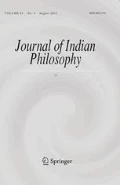Bibliography
Annabhaa. Tarkasa\(\underset{\raise0.3em\hbox{$\smash{\scriptscriptstyle\cdot}$}}{m} \) Edited with the author'sDīpikā and Govardhana'sNyāyabodhinī by Yashwant Vasudev Athalye and Mahadev Rajaram Bodas. Bombay Sanskrit Series 55. Poona: Bhandarkar Oriental Research Institute, 1974.
Bhattacharya, Tarasamkar (1945, 1946). The Five Provisional Definitions of Vyāpti',Journal of the Ganganatha Jha Research Institute 3 (1945): 67–89, 315–349; 4 (1946): 169–188.
Bhattacharya, Tarasamkar (1970).The Nature of Vyāpti. Calcutta: Calcutta Sanskrit College.
Bocheński, I. M. (1956).Formale Logik. Munchen: Verlag Karl Alber Freiburg.
Gageśa Upādhyāya. Tattvacintāma\(\underset{\raise0.3em\hbox{$\smash{\scriptscriptstyle\cdot}$}}{n} \). Edited with the Tattvacintāma\(\underset{\raise0.3em\hbox{$\smash{\scriptscriptstyle\cdot}$}}{n} \) by Kāmākhyānātha Tarkavāgīśa, Calcutta: Asiatic Society of Bengal, 1884–1901.
Goekoop, C. (1967). The Logic of Invariable Concomitance in the Tattvacintā-ma\(\underset{\raise0.3em\hbox{$\smash{\scriptscriptstyle\cdot}$}}{n} \). Dordrecht: D. Reidel Publishing Company.
Hariram Shukla.Vyākhyā. A commentary on theTattvacintāma \(\underset{\raise0.3em\hbox{$\smash{\scriptscriptstyle\cdot}$}}{n}\) irahasya. See Mathurānātha's Māthurī Pañcalak \(\underset{\raise0.3em\hbox{$\smash{\scriptscriptstyle\cdot}$}}{s}\) a \(\underset{\raise0.3em\hbox{$\smash{\scriptscriptstyle\cdot}$}}{s}\) a \(\underset{\raise0.3em\hbox{$\smash{\scriptscriptstyle\cdot}$}}{n}\) ī.
Ingalls, Daniel H. H. (1951).Materials for the Study of Navya-Nyāya Logic. Harvard Oriental Series 40. Cambridge, Mass.: Harvard University Press.
Kaviraj, Gopinath (1961). Gleanings from the History and Bibliography of the Nyāya-Vaiśe\(\underset{\raise0.3em\hbox{$\smash{\scriptscriptstyle\cdot}$}}{s} \). Reprinted from the Saraswati Bhawan Series 3, 4, 5, and 7. Calcutta: Indian Studies, Past & Present.
Kitagawa, Hidenori (1978). Muktāvalīdarpa\(\underset{\raise0.3em\hbox{$\smash{\scriptscriptstyle\cdot}$}}{n} \). Studia Asiatica 3. Nagoya: Department of Indian Philosophy, University of Nagoya.
Maheśa Chandra Nyāyaratna. Navyanyāya-Bhā\(\underset{\raise0.3em\hbox{$\smash{\scriptscriptstyle\cdot}$}}{s} \)āpradīpa\(\underset{\raise0.3em\hbox{$\smash{\scriptscriptstyle\cdot}$}}{h} \) orBrief Notes on the Modern Nyāya System of Philosophy and Its Technical Terms. Edited with the commentarySuprabhā and Bengali translation by K. Tarkacharya, Calcutta: Calcutta Sanskrit College, 1973.
Mathurānātha Tarkavāgīśa. Māthurī Pañcalak\(\underset{\raise0.3em\hbox{$\smash{\scriptscriptstyle\cdot}$}}{s} \)a\(\underset{\raise0.3em\hbox{$\smash{\scriptscriptstyle\cdot}$}}{n} \) (K2). Edited with theVyākhyā of Hariram Shukla. Kashi Sanskrit Series 78. Benares: Chowkhamba Sanskrit Series Office, 1930.
Mathurānātha Tarkavāgīśa. Si\(\underset{\raise0.3em\hbox{$\smash{\scriptscriptstyle\cdot}$}}{m} \)havyāghralak\(\underset{\raise0.3em\hbox{$\smash{\scriptscriptstyle\cdot}$}}{s} a\underset{\raise0.3em\hbox{$\smash{\scriptscriptstyle\cdot}$}}{n} \) (K). Included in Vyāptipañcakarahasyam and Sinhavyāghralak\(\underset{\raise0.3em\hbox{$\smash{\scriptscriptstyle\cdot}$}}{s} a\underset{\raise0.3em\hbox{$\smash{\scriptscriptstyle\cdot}$}}{n} \) by Mathurānātha Tarkavāgīśa, edited with Ga\(\dot n\)gānirjharidn\(\underset{\raise0.3em\hbox{$\smash{\scriptscriptstyle\cdot}$}}{n} \) commentary and notes of Sivadatta Misra by Dhundhiraja Sastri. Kashi Sanskrit Series 64. Benares: Chowkhamba Sanskrit Series Office, 1928.
Mathurānātha Tarkavāgīśa.Tattvacintāma \(\underset{\raise0.3em\hbox{$\smash{\scriptscriptstyle\cdot}$}}{n}\)irahasya (BI). Included in Ga\(\dot n\)geśa'sTattvacintāma \(\underset{\raise0.3em\hbox{$\smash{\scriptscriptstyle\cdot}$}}{n}\)i. Mathurānātha Tarkavāgīśa.Vyāptipañcakarahasyam (K). See Mathurānātha'sSi \(\underset{\raise0.3em\hbox{$\smash{\scriptscriptstyle\cdot}$}}{m}\) havyāghralak \(\underset{\raise0.3em\hbox{$\smash{\scriptscriptstyle\cdot}$}}{s}\)a\(\underset{\raise0.3em\hbox{$\smash{\scriptscriptstyle\cdot}$}}{n}\)arahasyam.
Matilal, Bimal K. (1968).The Navya-nyāya Doctrine of Negation. Harvard Oriental series 46. Cambridge, Mass.: Harvard University Press.
Miyasaka Yuko (1983). ‘Navyanyāya ni okeru Śābdabodha no Kōzōbunseki’ (A Structural Analysis of Śābdabodha in Navyanyāya), Sa\(\underset{\raise0.3em\hbox{$\smash{\scriptscriptstyle\cdot}$}}{m} \)bhā\(\underset{\raise0.3em\hbox{$\smash{\scriptscriptstyle\cdot}$}}{s} \) 5: 3–23.
Miyasaka Yuko (1987). ‘The Definition ofVyāpti in Navyanyāya — its nature and construction with reference to Ga\(\dot n\)ngeśa and Raghunātha Śiroma\(\underset{\raise0.3em\hbox{$\smash{\scriptscriptstyle\cdot}$}}{n} \)i’, Sa\(\underset{\raise0.3em\hbox{$\smash{\scriptscriptstyle\cdot}$}}{m} \)bhā\(\underset{\raise0.3em\hbox{$\smash{\scriptscriptstyle\cdot}$}}{s} \) 9: 47–82.
Śaśadhara.Nyāyasiddhāntadīpa. Edited with the\(\underset{\raise0.3em\hbox{$\smash{\scriptscriptstyle\cdot}$}}{T} \)ippana of Gu\(\underset{\raise0.3em\hbox{$\smash{\scriptscriptstyle\cdot}$}}{n} \)aratnasūri by B. K. Matilal. L.D. Series 56. Ahmedabad: L.D. Institute, 1976.
Sen, Saileswar (1924).A Study of Mathurānātha's Rahasya. Wageningen.
Śivadatta Miśra. Ga\(\dot n\)ī. A commentary on theTattvacintāma \(\underset{\raise0.3em\hbox{$\smash{\scriptscriptstyle\cdot}$}}{n}\)irahasya. See Mathurānātha'sSi \(\underset{\raise0.3em\hbox{$\smash{\scriptscriptstyle\cdot}$}}{m}\) havyāghralak \(\underset{\raise0.3em\hbox{$\smash{\scriptscriptstyle\cdot}$}}{s}\)a\(\underset{\raise0.3em\hbox{$\smash{\scriptscriptstyle\cdot}$}}{n}\)arahasyam.
Staal, J. F. (1958). ‘Means of Formalization in Indian and Western Logic’,Proceedings of the XIIth International Congress of Philosophy. Venice, pp. 221–227.
Tachikawa, Musashi (1981).The Structure of the World in Udayana's Realism. Studies of Classical India 4. Dordrecht: D. Reidel Publishing Company.
Vidyabhushana, Satis Chandra (1970).A History of Indian Logic. Calcutta, 1978 (repr. Delhi: Motilal Banarsidass).
Viśvanātha Pañcānana.Nyāyasiddhāntamuktāvalī. Edited with the Kira\(\underset{\raise0.3em\hbox{$\smash{\scriptscriptstyle\cdot}$}}{n} \) of Srī K\(\underset{\raise0.3em\hbox{$\smash{\scriptscriptstyle\cdot}$}}{r} \underset{\raise0.3em\hbox{$\smash{\scriptscriptstyle\cdot}$}}{s} \underset{\raise0.3em\hbox{$\smash{\scriptscriptstyle\cdot}$}}{n} \)avallabhācārya by Narayancharan Shastri and Swetavaikuntha Shastri. Chowkhamba Sanskrit Series 212. Varanasi: Chowkhamba Sanskrit Series Office, 1972.
Wada, Toshihiro (1988a, 1988b). ‘Delimitor (avacchedaka) in Navya-nyāya Philosophy (1), (2)’,The Journal of the Faculty of Letters, Nagoya University 102, Philosophy 34 (1988a): 31–44;Tokai-Bukkyo 33 (1988b): 83–88.
Wada, Toshihiro (1988c). ‘Describer (nirūpaka) in Navya-nyāya’,Annals of Bhandarkar Oriental Research Institute 69: 183–194.
Wada, Toshihiro (1988d). ‘Qualifier (viśe\(\underset{\raise0.3em\hbox{$\smash{\scriptscriptstyle\cdot}$}}{s} \)) in Navya-nyāya Philosophy’,Journal of Indian and Buddhist Studies 37 (1): 500–506.
Wada, Toshihiro (1989). The Logical Validity of the Inferences in theSiddhān- talak\(\underset{\raise0.3em\hbox{$\smash{\scriptscriptstyle\cdot}$}}{s} \)aa Chapter of the Tattvacintāma\(\underset{\raise0.3em\hbox{$\smash{\scriptscriptstyle\cdot}$}}{n} \)idīdhiti’, Sa\(\underset{\raise0.3em\hbox{$\smash{\scriptscriptstyle\cdot}$}}{m} \)bhā\(\underset{\raise0.3em\hbox{$\smash{\scriptscriptstyle\cdot}$}}{s} \)ā 11: 23–37.
Wada, Toshihiro (1990).Invariable Concomitance in Navya-Nyāya. Delhi: Sri Satguru Publications.
Author information
Authors and Affiliations
Additional information
I wish to thank Charles Pain, University of California, Berkeley, for correcting my English.
Rights and permissions
About this article
Cite this article
Wada, T. Ga\(\dot n\) \(\underset{\raise0.3em\hbox{$\smash{\scriptscriptstyle\cdot}$}}{m} \) \(\underset{\raise0.3em\hbox{$\smash{\scriptscriptstyle\cdot}$}}{s} \) \(\underset{\raise0.3em\hbox{$\smash{\scriptscriptstyle\cdot}$}}{n} \)na of VYĀPTI (1). J Indian Philos 23, 273–294 (1995). https://doi.org/10.1007/BF01463134
Issue Date:
DOI: https://doi.org/10.1007/BF01463134

